SaaS HR Explained: Features, Types & Future Trends
Explore SaaS HR features, types, setup tips, challenges, and future trends to simplify workforce management and pick the right software.
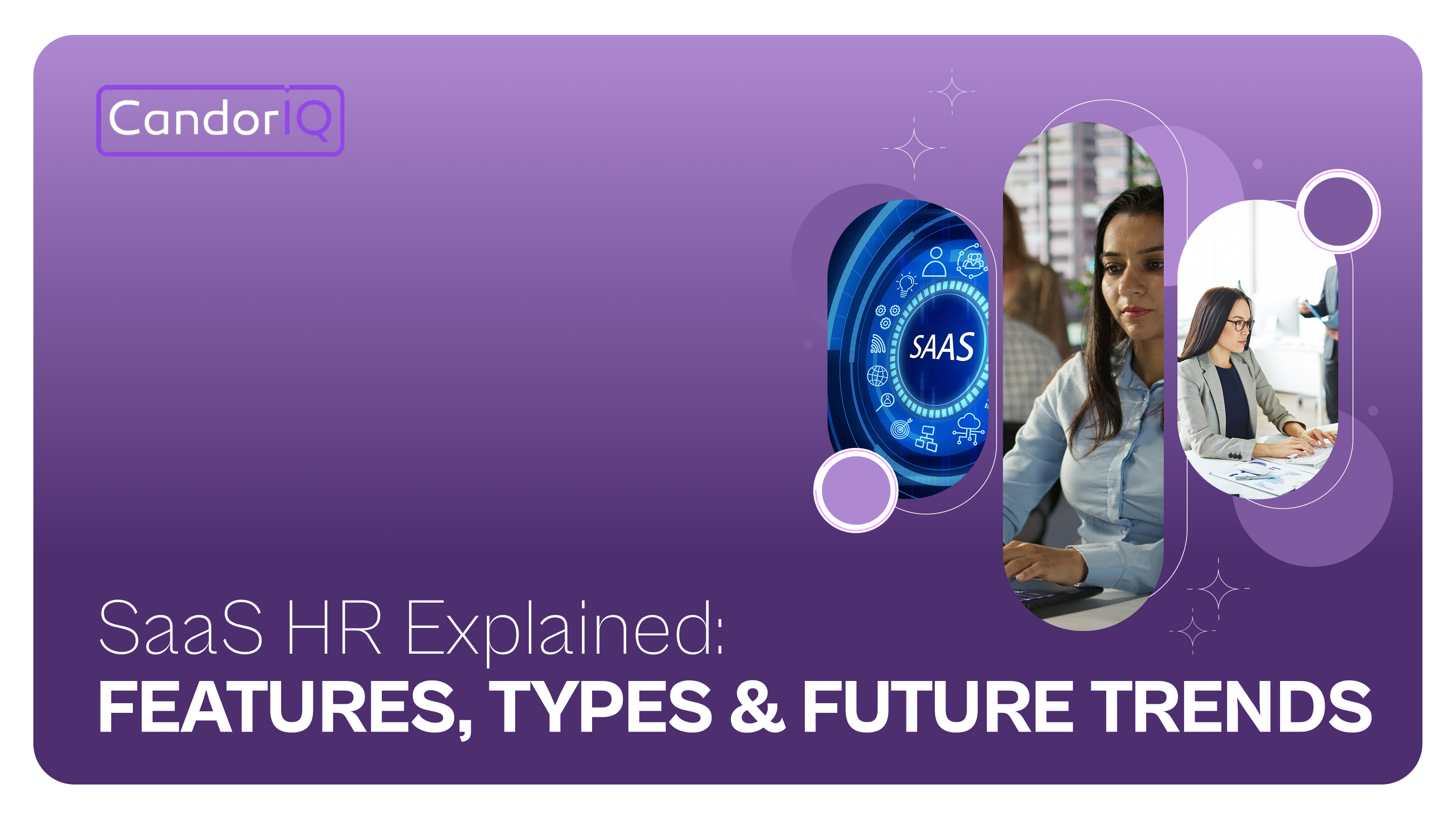
As businesses grow faster than ever, managing human resources has become both more challenging and more critical. Traditional HR methods can feel outdated; often manual, time-consuming, and prone to mistakes, making it hard to keep up with the needs of an effective workforce.
We understand how overwhelming it can be to juggle payroll, recruitment, and employee management all at once, especially when manual processes slow you down and increase the risk of errors. That’s where SaaS HR systems step in, offering a smarter and more efficient way to handle everything from recruitment to payroll.
These platforms centralize employee data, simplify workflows, and reduce the risk of errors. They also provide real-time insights, helping HR teams make informed decisions and focus on strategic initiatives rather than repetitive tasks.
In this blog, you'll explore the essential features of SaaS HR, the different types of tools you might consider, and the emerging trends that are transforming how HR departments work.
Key Takeaways:
- SaaS HR systems centralize employee data, payroll, performance, and attendance, reducing errors and manual work.
- Integrated Applicant Tracking simplifies hiring, from job postings to interviews and onboarding.
- Analytics, reporting, and automated compliance support smarter decisions and regulatory alignment.
- Mobile-friendly platforms and integrations let employees and HR teams manage tasks remotely and keep workflows seamless.
- Automation of routine HR tasks boosts efficiency, frees teams for strategic work, and improves the overall employee experience.
What is SaaS HR?
SaaS HR is a cloud-based way of managing key HR functions like employee data, payroll, performance tracking, and recruitment.
Instead of using traditional systems that require heavy IT setup and maintenance, SaaS HR operates in the cloud and is accessible through a subscription. That means teams can access it from anywhere, and updates happen automatically.
For mid-sized and growing companies, especially those hiring fast or managing remote teams, SaaS HR offers a single platform to simplify HR work.
It cuts down on manual tasks, improves data accuracy, and gives HR and finance leaders real-time visibility into workforce operations. This frees up lean HR teams to focus on strategy and people, not paperwork.
Now that you know what SaaS HR is, it's helpful to compare it with traditional HR software to understand the key differences and why many organizations are making the switch.
SaaS HR vs Traditional HR Software: What’s the Difference?
Choosing the right HR software can make a big difference in how smoothly your team handles payroll, talent management, and workforce planning. As businesses grow, a common question comes up: should we continue with traditional on-premise systems or move to a cloud-based SaaS HR solution?
Understanding the strengths and trade-offs of both options can help you find the best fit, especially if you're scaling fast, managing a remote workforce, or operating with a lean HR team.
Understanding the differences between SaaS HR and traditional software helps you identify the most critical features when selecting the right system for your organization.
Top Features to Look for in a SaaS HR System
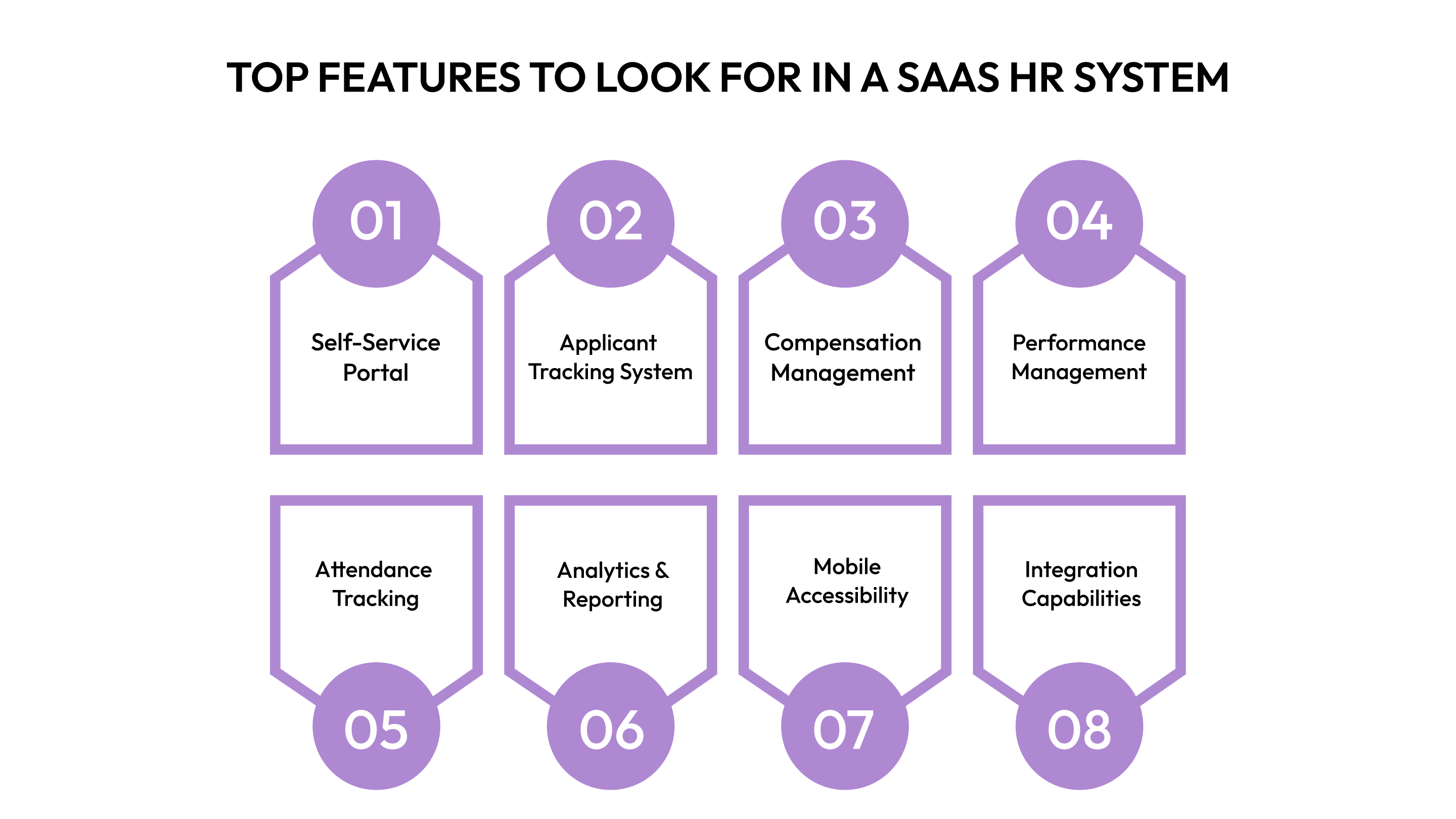
SaaS HR systems offer the flexibility, scalability, and automation needed to simplify everything from hiring to payroll. But choosing the right solution means looking beyond just the basics.
It’s important to focus on features that improve day-to-day workflows, boost employee engagement, and deliver strategic insights that help drive smarter decisions. Here are the top key features to look for in a SaaS HR system.
Centralized Employee Database & Self-Service Portal
A centralized employee database gives HR teams one secure place to store and manage all employee-related information. This information includes personal details, performance records, and work history.
When paired with a self-service portal, it empowers employees to handle easy tasks on their own, such as updating personal info, downloading pay slips, requesting time off, or accessing HR documents.
This allows:
- Real-time access: Both HR and employees can access the most updated information anytime, from anywhere.
- Employee empowerment: Self-service reduces dependency on HR for day-to-day queries and allows HR to focus on talent strategy or employee engagement.
- Data accuracy: A single, centralized system improves consistency, reduces errors, and simplifies audits or compliance reviews.
Recruitment & Applicant Tracking System (ATS)
An integrated ATS helps automate and manage the entire recruitment journey, from posting job listings to tracking applications and coordinating interviews. It replaces scattered tools and manual processes with a unified system that keeps everything organized.
This allows:
- Automated job postings: Easily publish job openings across job boards, career pages, and social platforms from one place.
- Efficient candidate tracking: View and manage candidates at every stage of the hiring funnel, ensuring no one is missed or overlooked.
- Simplified communication: Centralized messaging keeps candidate interactions professional and timely, improving the overall candidate experience.
Payroll & Compensation Management
A SaaS HR system with built-in payroll and compensation management automates everything, from salary calculations and benefits administration to tax compliance and payslip generation.
This allows:
- Automated payroll processing: Makes sure employees are paid correctly and on time without manual intervention.
- Tax compliance: Built-in tax logic keeps you aligned with local, state, and federal regulations, reducing the risk of penalties.
- Integrated compensation data: Aligns employee records with salary, bonuses, and benefits, creating transparency and consistency across the organization.
Performance Management Tools
A modern SaaS HR system includes tools for setting goals, managing feedback, and conducting performance reviews, all aligned with your business objectives. It supports a culture of continuous development and accountability.
This allows:
- Goal setting: Employees and managers can collaboratively set SMART goals that align with company priorities.
- Continuous feedback: Real-time or regular feedback helps employees course-correct and grow, rather than waiting for annual reviews.
- Structured appraisals: Digitized reviews, progress tracking, and feedback documentation ensure fair and data-driven performance evaluations.
Time & Attendance Tracking
Tracking working hours, leaves, and overtime is essential for accurate payroll and compliance. A SaaS HR solution with built-in time and attendance tracking simplifies this process, reducing manual errors and administrative overhead.
This allows:
- Accurate time tracking: Employees can record their working hours or clock in/out digitally, reducing discrepancies.
- Leave management: Employees can request leave, and HR or managers can approve it based on real-time availability and policies.
- Compliance support: Ensures adherence to labor laws related to working hours, rest periods, overtime, and leave entitlements.
Analytics & Reporting
Advanced reporting and analytics tools in SaaS HR platforms turn raw HR data into actionable insights. From workforce trends to engagement and retention metrics, these tools help organizations make smarter decisions backed by data.
This allows:
- Real-time dashboards: Visualize key metrics like headcount, turnover, hiring pipeline, and performance trends at a glance.
- Custom reports: Create reports tailored to your specific KPIs, whether you’re tracking diversity, pay equity, or training outcomes.
- Predictive analytics: Use AI to forecast future workforce needs, identify skill gaps, and spot early signs of attrition.
Mobile Accessibility
As employees work remotely or on the go, mobile access to HR systems is no longer optional. A mobile-friendly SaaS HR platform ensures employees and HR teams stay connected and productive, wherever they are.
This allows:
- On-the-go learning: Employees can complete training or access resources from their phones.
- Real-time updates: Check schedules, apply for leave, or view announcements through the mobile app.
- Remote HR management: HR teams can manage approvals, track metrics, and support employees without being tied to a desk.
Integration Capabilities
A strong SaaS HR solution should integrate smoothly with your other business systems, like payroll, finance, learning platforms, and productivity tools, to create a unified experience.
This allows:
- Smooth workflows: Integration across systems reduces repetitive data entry and keeps everything in sync.
- Automated processes: Automates key workflows such as onboarding, benefits enrollment, or compensation adjustments.
- Centralized data: A single source of truth across systems improves data quality and decision-making.
After knowing the key features that make a SaaS HR system effective, it’s useful to explore the main types of tools available and how each can support different HR needs.
Also Read: How to Calculate Total Employee Compensation: A Step-by-Step Guide
3 Main Types of SaaS HR Tools You Should Know
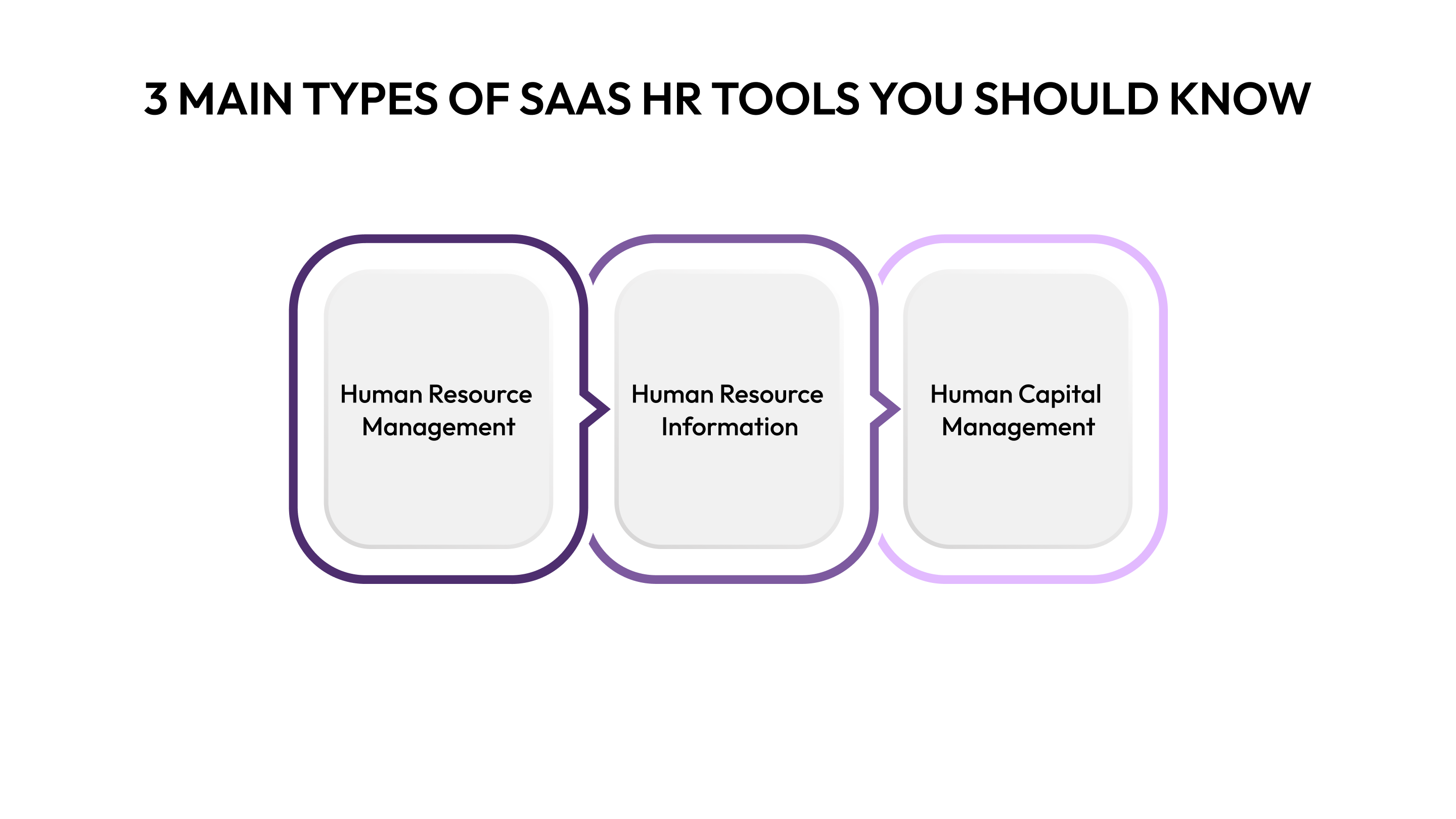
Today, a wide range of tools is available to help simplify different areas of human resource management. Depending on what your organization needs, whether it’s simplifying payroll, improving recruitment, or boosting employee engagement, there’s a solution designed to support that goal.
Let’s take a closer look at the three main types of SaaS HR tools and what they bring to the table:
1. HRMS (Human Resource Management System)
An HRMS is a comprehensive platform that brings together multiple HR functions into a single system. It helps HR teams manage everything from hiring and payroll to performance reviews and employee development, all in one place.
For organizations looking to handle the full employee lifecycle with minimal manual work, an HRMS offers an all-in-one solution. It includes key features, such as:
- Employee records management: Keep track of personal details, job history, qualifications, and more.
- Recruitment and onboarding: Simplify job postings, applicant tracking, and onboarding programs for new hires.
- Payroll and compensation: Automate salary calculations, deductions, tax filings, and ensure timely payments.
- Performance management: Set goals, collect feedback, and run performance evaluations.
An HRMS is especially valuable for mid-sized and fast-growing companies. It reduces admin work, increases efficiency, and helps maintain consistent data across various HR functions, all within a single platform.
2. HRIS (Human Resource Information System)
Think of an HRIS as the foundation of your HR tech stack. It focuses mainly on storing and managing employee information, such as personal details, roles, pay history, and attendance records.
While it may include a few basic HR functions, the core purpose of an HRIS is to centralize employee data and make reporting and compliance easier. It includes key features, such as:
- Centralized employee database: Store essential details like compensation history, contact info, and performance notes.
- Time and attendance tracking: Log work hours, overtime, vacation, and sick leave.
- Compliance management: Help ensure employee data is stored in line with legal and regulatory requirements.
- Reporting and analytics: Generate accurate workforce reports for audits, planning, or trend analysis.
HRIS tools are ideal for organizations that need a reliable way to manage employee data without a full-featured HRMS. They make it easier to maintain accurate records, support compliance, and keep a pulse on your workforce through clean, consistent data.
3. HCM (Human Capital Management)
HCM systems go beyond just managing employee information; they focus on optimizing workforce potential and aligning HR initiatives with broader business goals.
From hiring to leadership development, HCM tools help organizations manage talent strategically and drive long-term growth. This includes key features:
- Talent acquisition: Simplify the hiring process to attract and onboard the right talent quickly.
- Employee development: Support upskilling, training programs, mentorship, and career path planning.
- Succession planning: Identify future leaders and prepare them for key roles.
- Compensation management: Manage pay structures, bonuses, equity, and performance-linked rewards.
HCM platforms are best suited for larger organizations or enterprises focused on performance, engagement, and long-term workforce planning. These tools help create a strategic HR function that supports business goals and drives them forward by investing in people.
Understanding the different types of SaaS HR tools makes it easier to choose the one that fits your organization. Knowing your options helps you pick software that truly meets your business needs.
How to Pick the Right HR Software for Your Business?

Choosing the right HR software plays a big role in improving efficiency, staying compliant, and keeping employees engaged. To get the most value, it’s essential to select the one that fits your current needs while also being flexible enough to grow with your organization.
Below is a step-by-step guide to help you find the right HR software for your business:
Identify Your Organization’s HR Needs
Before selecting any HR software, the first step is to assess your organization’s unique needs. What are the primary HR challenges you’re facing? Are you struggling with recruitment, payroll, performance management, or employee engagement?
You can follow these steps:
- Evaluate key HR functions like recruitment, payroll, training, employee management, and performance evaluation.
- Discuss with HR team members and managers to identify pain points and areas for improvement.
- Consider future growth and whether the system can scale as your organization expands.
Consider the Size & Growth of Your Organization
The size of your business plays a big role in determining which HR software is best suited for your needs. However, for larger organizations with more complex requirements, an HCM system may be a better fit. Additionally, you should consider how the software will scale as your organization grows.
For that, follow these steps:
- Determine whether your business needs a comprehensive HRMS, which integrates multiple HR functions, or a more focused HRIS for managing employee data.
- Ensure the software can scale as your headcount and operations expand.
- Check for flexibility in pricing and features as your needs evolve.
Look for Key Features That Align with Your HR Strategy
The right software should align with your HR strategy and business goals. It should offer the features that will enable you to manage and develop your workforce effectively.
The key features to look for are as follows:
- Employee management (centralized database, employee records)
- Performance management (goal setting, feedback, reviews)
- Recruitment and onboarding (ATS, job postings, interview scheduling)
- Payroll and compensation management (automated payroll, tax compliance)
- Analytics and reporting (data-driven insights, custom reporting)
- Mobile access (remote access for employees and HR teams)
To choose the right software, you can follow these steps:
- Identify which HR functions are most important to your organization (e.g., recruitment, performance management).
- Focus on software that integrates key features like personalized learning, payroll automation, and performance tracking to streamline HR tasks.
- Ensure that the system supports your HR strategy and enhances employee engagement.
Ensure Integration Capabilities with Existing Systems
HR software should integrate smoothly with your existing systems, like accounting, payroll, and learning management systems (LMS). For that, follow these steps:
- Check if the software can integrate with your existing payroll and finance tools.
- Look for integration with other key business systems, such as CRM, ATS, or ERP, to streamline operations.
- Test the integration process with your existing IT systems to ensure a smooth data sync.
Prioritize User Experience and Employee Engagement
HR software should be easy for HR professionals to use and intuitive for employees. An employee-friendly interface enhances engagement and encourages adoption across the organization. This ensures that employees actively interact with the system.
For that, follow these steps:
- Look for software with an intuitive interface that’s simple to navigate for both HR teams and employees.
- Consider self-service portals that allow employees to view their information, request time off, and complete training independently.
- Provide employees with the tools they need to engage with the software, like mobile apps or chatbots for quick responses.
Check for Security and Compliance Features
As HR systems handle sensitive employee data, data security and compliance are non-negotiable. Ensure that the software complies with local and global regulations, such as CCPA, and provides strong security features to protect sensitive data.
For that, follow these steps:
- Ensure the software provider has security certifications (e.g., SOC 2 Type II, HIPAA).
- Check that the system complies with data privacy laws in the regions where your business operates.
- Look for features like encryption, two-factor authentication, and role-based access control to safeguard sensitive employee data.
Consider Vendor Support and Customer Service
Good customer support can make or break the adoption of any HR software. Choose a vendor that offers excellent customer service and is committed to providing ongoing support and training as your team adapts to the new system.
For that, follow these steps:
- Review the vendor’s support offerings, including live chat, phone support, and knowledge bases.
- Look for vendors that provide training resources, like tutorials and onboarding sessions, to get your team up and running quickly.
- Consider a vendor who offers consultation services to help you tailor the system to your business needs.
Once you’ve chosen the right HR software, it’s interesting to see how SaaS HR can simplify day-to-day workforce management and make HR processes more efficient.
You Might Also Like: How to Excel in Talent and Workforce Planning?
How SaaS HR Makes Workforce Management Easier?
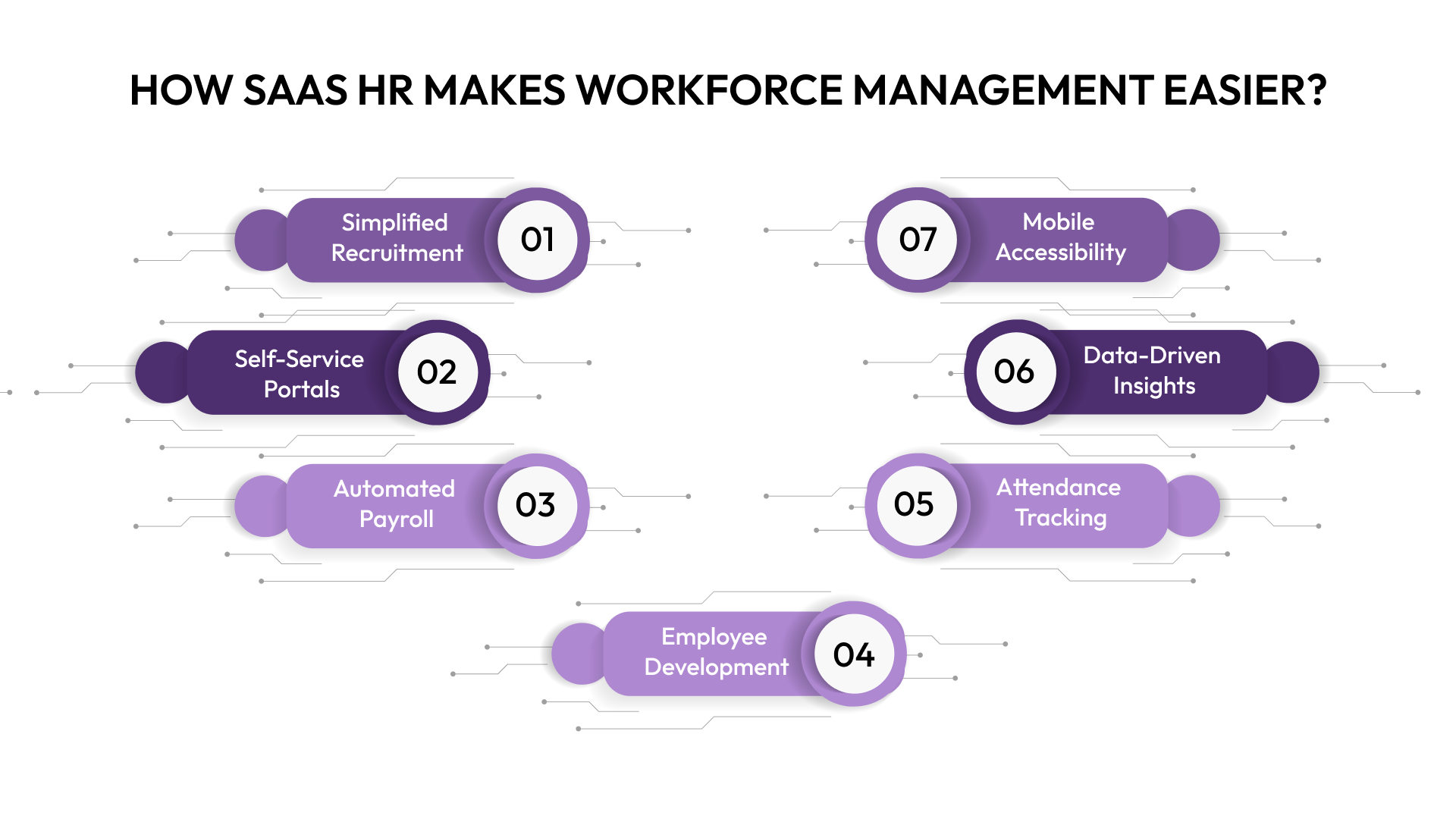
Managing a growing and effective workforce comes with its fair share of challenges. SaaS HR solutions are cloud-based platforms built to automate and simplify these functions.
These modern tools are reshaping the way HR teams work by making workforce management more efficient, adaptable, and scalable. Here’s how SaaS HR simplifies and enhances workforce management.
Simplified Recruitment and Onboarding
SaaS HR platforms typically come with a built-in Applicant Tracking System (ATS) that automates job postings, tracks applicants, and manages interview scheduling. It helps in workforce management through:
- Wider reach with less effort: Post job listings across multiple job boards and platforms with a single click.
- Better visibility into candidate status: Keep tabs on applicants throughout every stage of the hiring process.
- Smoother onboarding: Pre-configured workflows and digital documentation make it easy for new hires to get up to speed, minimizing paperwork and manual coordination.
Centralized Employee Data and Self-Service Portals
A SaaS HR solution brings everything into one place, giving HR teams and employees real-time access to essential data. It helps in workforce management through:
- Up-to-date information: HR teams can access accurate employee records anytime, reducing errors and decision-making delays.
- Empowered employees: Staff can update personal details, submit leave requests, and download payslips on their own.
- Cross-functional visibility: HR, Finance, and Operations can all work from the same source of truth, improving collaboration.
Automated Payroll and Compensation Management
SaaS HR systems automate payroll processing, salary calculations, tax deductions, and benefits, making the whole process more reliable and transparent. It helps in workforce management through:
- Fewer mistakes: Automation ensures employees are paid correctly and on time, every time.
- Smooth integration: Time and attendance data flow directly into payroll, ensuring pay reflects actual hours worked.
- Built-in compliance: Tax calculations are automatically updated to reflect local, state, and federal regulations.
Performance Management & Employee Development
SaaS HR platforms often include tools for continuous feedback, goal setting, and development planning, making it easier to keep employees aligned and motivated. It helps in workforce management through:
- Real-time progress tracking: Managers and employees can monitor goals and adjust them as needed.
- Consistent feedback loops: Frequent check-ins replace infrequent reviews, encouraging better communication and performance.
- Simplified evaluations: Built-in review templates and automated reminders ensure that appraisals happen on time and are well-documented.
Time and Attendance Tracking
A SaaS HR system automates this function, reducing errors and saving time. It helps in workforce management through:
- Clock in/out digitally: Employees can log hours via desktop or mobile, improving accuracy and accountability.
- Automated leave tracking: Employees request time off through the system; managers approve or deny in real-time.
- Tighter compliance: Ensure labor law compliance with proper records for overtime, breaks, and sick leave.
Data-Driven Insights and Reporting
SaaS HR tools manage data and help you make sense of it. Advanced reporting and analytics tools turn raw HR data into actionable insights that guide the right business decisions. It helps in workforce management through:
- Real-time dashboards: Monitor trends like attrition, engagement, hiring velocity, and training completion.
- Custom reports: Create targeted reports to evaluate programs, track diversity, or identify productivity gaps.
- Predictive insights: Use AI to spot emerging trends, like potential turnover, before they become bigger issues.
Mobile Accessibility for Remote Workforces
Today’s teams are often remote, hybrid, or spread across multiple locations. SaaS HR platforms with mobile capabilities ensure everyone stays connected, no matter where they work. It helps in workforce management through:
- On-the-go access: Employees can manage leave, check schedules, and complete training from their mobile devices.
- Remote HR management: HR teams can handle approvals, performance tracking, and employee support from anywhere.
- Mobile learning: Offer training materials in a format employees can access anytime, boosting participation and engagement.
Platforms like CandorIQ combine all these features into a unified, AI-powered system, helping HR teams manage employees efficiently while supporting strategic business goals.
Knowing how SaaS HR can simplify workforce management is just the start. To get the most out of your system, following some best practices during setup can make a big difference.
Best Practices to Follow When Setting Up SaaS HR
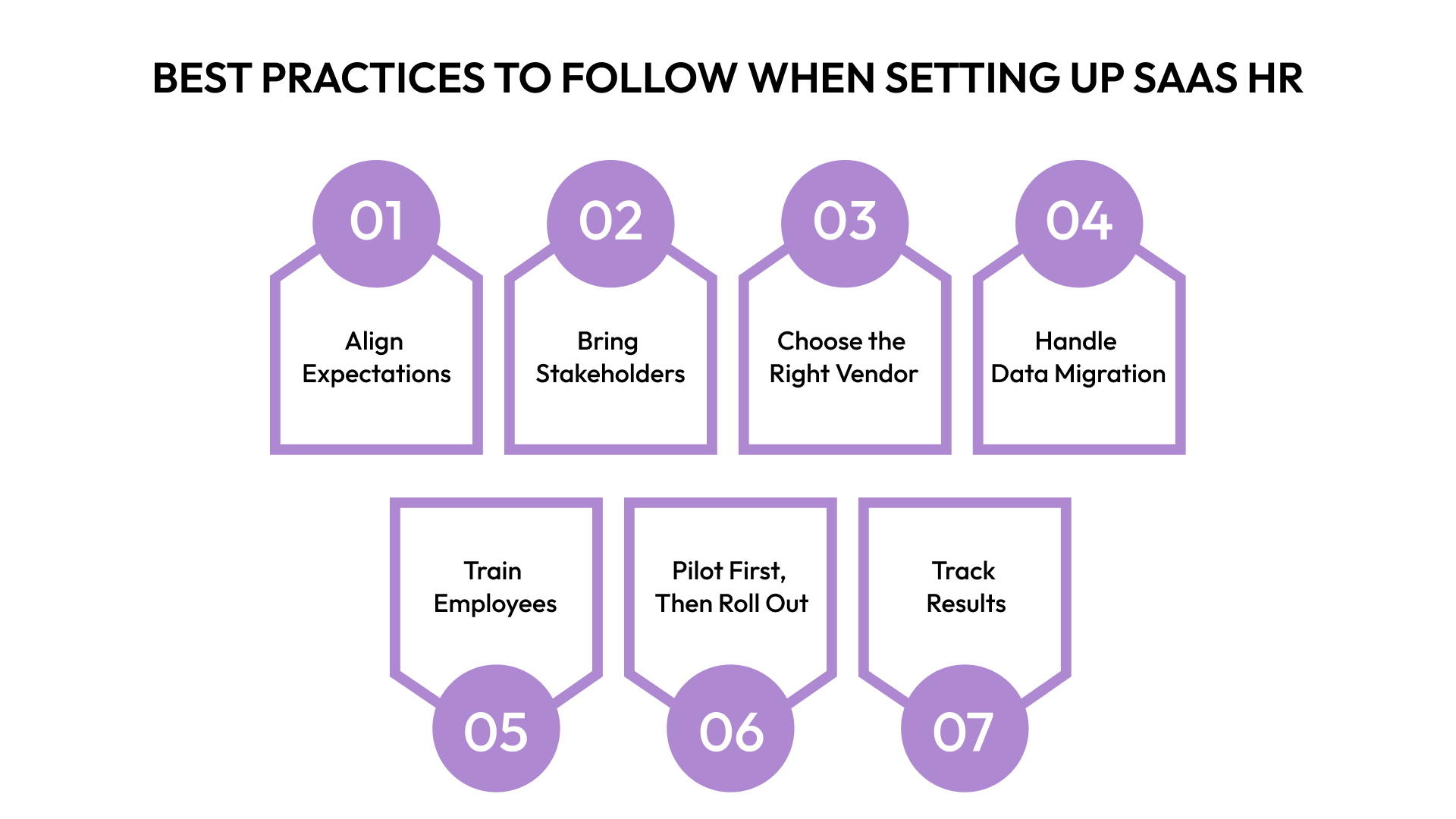
Switching to a SaaS HR system can be a big win for HR teams in mid-sized and growing companies. But to get the most out of your new system, the setup needs to be done right. A well-planned rollout ensures a smooth transition, better adoption by employees, and results that actually match your goals.
Below is a step-by-step guide to help you set up your SaaS HR system the right way.
1. Set Clear Goals and Align Expectations
Be clear on why you’re implementing a new SaaS HR system in the first place. Are you trying to speed up hiring, automate payroll, simplify performance reviews, or improve employee engagement?
Knowing your goals up front helps you stay focused and ensures the system supports your broader HR strategy. For that:
- Talk to key stakeholders and align on specific challenges and priorities.
- Define what success looks like, for example, faster time-to-hire, higher employee satisfaction, or more accurate HR data.
2. Bring Stakeholders in Early
Getting the right people involved from the start, like HR, IT, finance, and team managers, makes implementation smoother. When people feel heard and included, they’re more likely to support the change and use the system. For that:
- Schedule cross-functional meetings to understand each team’s needs.
- Involve end-users like HR staff and employees early, whether through testing or feedback sessions.
3. Choose the Right Vendor
Your choice of vendor can significantly impact your HR technology experience. Look for a solution that’s easy to use, offers solid support, and can scale as your business grows. The system should also work well with the tools you already use. For that:
- Compare vendors based on ease of integration, customer support, data security, and pricing.
- Look for a partner that understands your industry and the unique needs of your business.
4. Handle Data Migration Carefully
Moving data from your old systems to the new platform is one of the most critical (and sometimes tricky) steps. Clean, accurate data is key to making your new HR system work properly from day one. For that:
- Begin by conducting a thorough data check, removing outdated information, correcting errors, and organizing files.
- Work with your IT team and the vendor to ensure smooth transfer and proper integration with payroll, ATS, and performance tools.
- Conduct regular data audits post-migration to ensure everything is accurate and up-to-date.
5. Train Employees the Right Way
Even the best system won’t get used if people don’t know how to use it. That’s why training is just as important as the technology itself. Make it easy for employees to get familiar with the platform, and don’t forget to train your HR team in depth. For that:
- Run hands-on training for HR teams and managers so they’re confident using every feature.
- Offer simple how-to guides and walkthroughs for employees, covering essentials like applying for leave, updating details, or accessing payslips.
- Hold open Q&A sessions or set up a help desk during the initial rollout.
6. Pilot First, Then Roll Out
Before going live across the whole company, it’s smart to test the system with a smaller group. A pilot phase gives you the chance to catch issues early and fine-tune the system based on real feedback. For that:
- Pick a department or group to run a short pilot program.
- Monitor performance and watch for technical bugs or usability problems.
- Use feedback to refine processes and make improvements before full deployment.
7. Track Results and Keep Improving
Keep an eye on how your SaaS HR system is performing and whether it’s meeting the goals you set at the beginning. Ongoing feedback and regular check-ins will help you keep improving over time. For that:
- Monitor key metrics like employee adoption, time-to-hire, payroll accuracy, and system usage.
- Collect input from employees and managers on how the system is working for them.
- Use built-in analytics to gain insights and identify areas where HR processes can be made even better.
Even with best practices in place, challenges can still arise when using SaaS HR. Understanding common issues and how to address them helps ensure your system runs smoothly.
Common SaaS HR Challenges & How to Tackle Them
While SaaS HR systems offer numerous benefits, they also present a few challenges. Knowing what to expect can help you go through issues more effectively and get the most out of your investment.
Here are some of the most common challenges with SaaS HR systems and how to handle them with confidence.
While handling common challenges keeps your SaaS HR system running smoothly today, it’s also helpful to look ahead at future trends shaping how these tools will evolve.
Also Read: How to Choose the Right HR Software Guide
Future Trends in SaaS HR
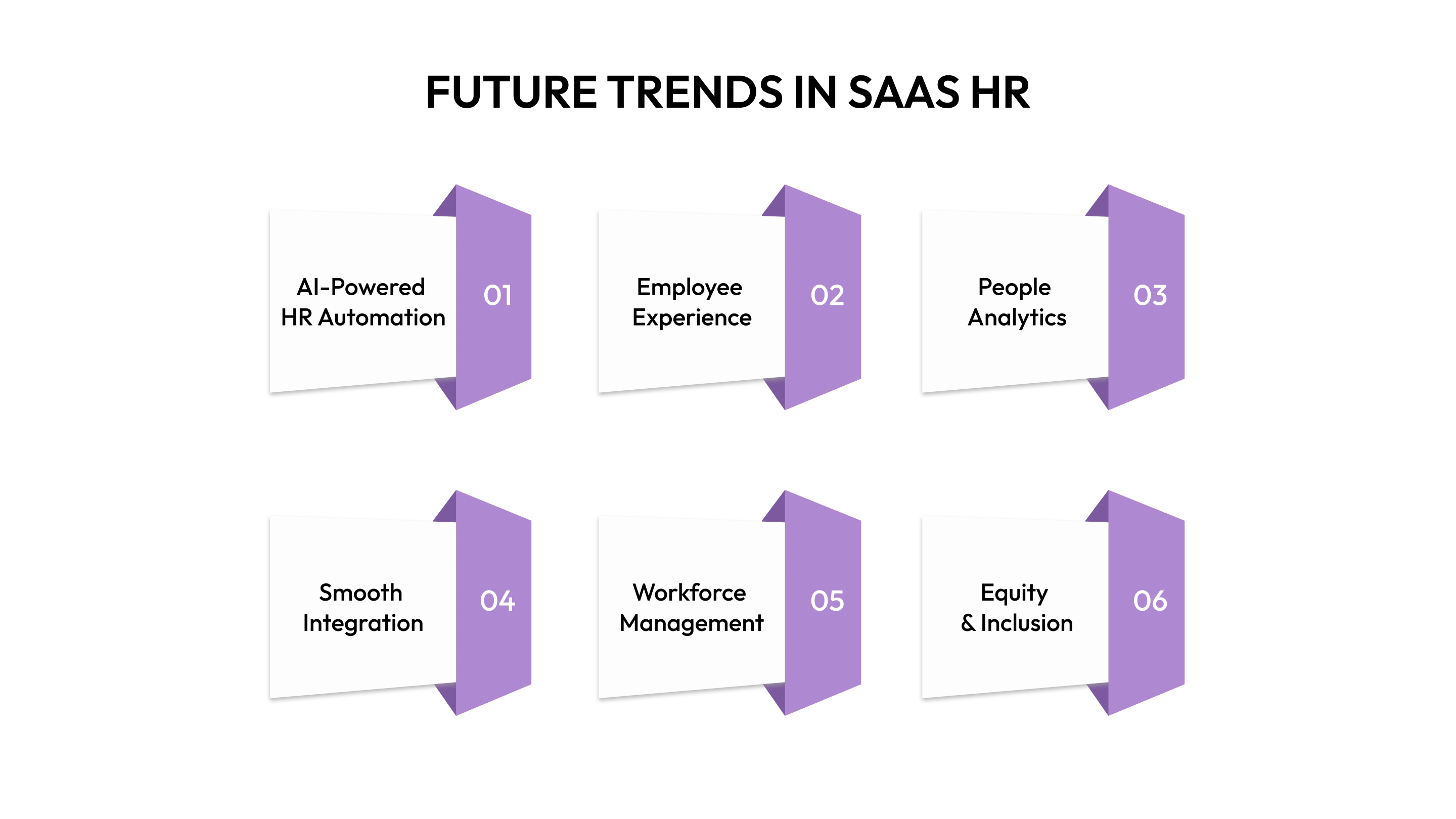
As the way we work continues to change, so do the tools we rely on to manage people and processes. SaaS HR systems have already made a big impact by simplifying HR operations, but they’re also evolving fast. Below are some of the top trends that are shaping the future of SaaS HR:
AI-Powered HR Automation
AI is quickly becoming an important part of SaaS HR platforms, and that trend isn’t slowing down. From hiring to payroll, performance tracking to engagement, AI helps automate repetitive tasks while offering deeper insights through real-time data analysis.
Key future trends include:
- AI-based tools that screen resumes and schedule interviews will help recruiters focus more on connecting with candidates.
- Personalized learning paths will guide employees toward growth opportunities that match their skills and career goals.
- AI chatbots will take over routine questions, like leave policies or payslip queries, freeing up HR teams for more strategic work.
A Stronger Focus on Employee Experience
Today’s employees want more than just a smooth onboarding or easy access to payslips. They want to feel valued, supported, and empowered. That’s why modern SaaS HR systems are shifting toward a more holistic employee experience, supporting well-being, growth, and day-to-day engagement.
Key future trends include:
- Real-time feedback tools to track employee sentiment and quickly respond to concerns.
- Smart learning platforms that recommend courses based on goals and performance.
- More intuitive self-service portals that give employees control over their data, benefits, and career development.
People Analytics and Predictive Insights
Data-driven HR is becoming essential. People analytics in SaaS platforms now go beyond basic reports to deliver predictive insights. This means HR teams can move from reacting to problems to anticipating and preventing them.
Key future trends include:
- Forecasting tools to predict workforce needs, hiring trends, and potential skill gaps.
- Engagement data that signals early signs of burnout or attrition risk.
- Dashboards offering real-time views into key metrics like diversity, performance, and retention.
Smooth Integration Across Business Functions
HR can’t operate in a silo anymore. The next wave of SaaS HR platforms will integrate more deeply with other business systems, like finance, operations, and customer success. This offers a more connected view of people and performance across the company.
Key future trends include:
- Real-time syncing between payroll, finance, and HR systems for accurate reporting and budgeting.
- Tools that support cross-department collaboration on hiring plans, workforce allocation, or project staffing.
- Shared data dashboards that help leadership connect employee outcomes with business performance.
Better Tools for Remote and Hybrid Workforce Management
Remote and hybrid work are here to stay, and SaaS HR systems are adapting fast. Future-ready platforms will focus on supporting distributed teams, helping HR leaders keep engagement, communication, and productivity high.
Key future trends include:
- Cloud-based systems that let HR manage everything, from hiring to performance reviews, remotely.
- Tools that promote connection, like virtual team-building, peer feedback, and remote wellness check-ins.
- Features to track remote productivity and well-being without becoming intrusive.
A Deeper Commitment to Diversity, Equity, and Inclusion (DEI)
DEI is a fundamental part of building a healthy workplace. SaaS HR systems are stepping up with tools that make it easy to track, manage, and grow inclusive practices throughout the employee lifecycle.
Key future trends include:
- DEI dashboards to monitor representation and identify potential gaps in hiring, promotions, and pay.
- Bias-checking features are built into recruitment workflows to support fairer hiring decisions.
- Inclusive learning programs tailored to different learning styles, backgrounds, and career paths.
Wrapping Up
As compensation strategies evolve, HR teams need to stay in step with market trends and employee expectations. Modern compensation benchmarking tools give HR professionals the insights they need to design pay structures that are competitive, fair, and data-driven.
With these innovations, HR can do more than just attract and retain talent; they can build a workplace founded on trust, equity, and transparency.
CandorIQ provides advanced tools to manage compensation, optimize rewards, and maintain full transparency. It helps you stay ahead and create a compensation strategy that truly supports your business goals.
Book a demo with CandorIQ today and see how our platform can help you build a more equitable, data-driven HR environment.
FAQs
Q1. How does SaaS HR improve recruitment and talent acquisition?
A1. SaaS HR systems make recruitment smoother and more efficient. They often include AI-powered resume screening, automated interview scheduling, and candidate tracking. These tools also make it easier for HR teams to collaborate, monitor candidate progress, and maintain a transparent hiring process.
Q2. Can SaaS HR systems integrate with other business software?
A2. Yes. Most SaaS HR platforms can connect with other business tools like payroll systems, finance platforms, ATS (Applicant Tracking Systems), and project management software. This ensures smooth data flow across departments and reduces manual work.
Q3. How does SaaS HR ensure data security?
A3. Security is a top priority for SaaS HR systems. They typically use encryption, multi-factor authentication, and regular security audits to protect sensitive employee data. Many cloud providers also comply with strict standards like CCPA, ensuring HR data is handled safely and responsibly.
Q4. What is the difference between HRMS and HRIS in SaaS HR systems?
A4. HRMS (Human Resource Management System) is a comprehensive tool that integrates multiple HR functions, including payroll, benefits, and recruitment. HRIS (Human Resource Information System), on the other hand, focuses mainly on storing and managing employee information.


